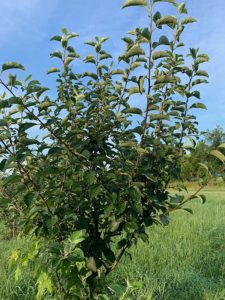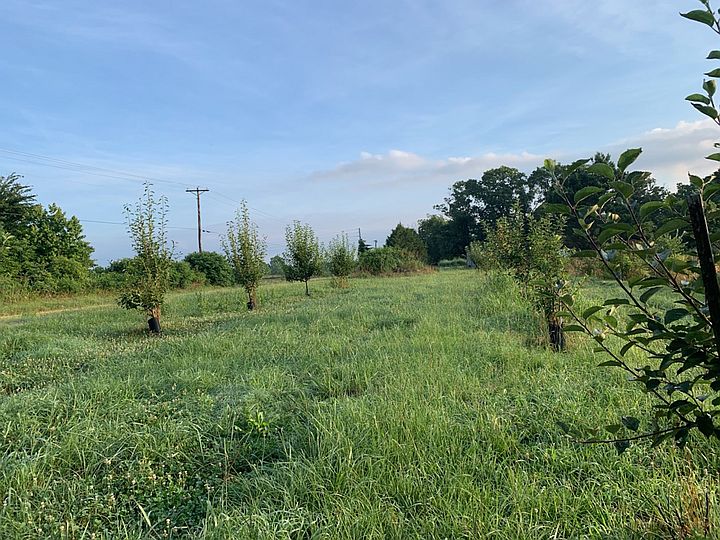Small and Full Shares
- Carrots
- Fingerling Potatoes
- Eggplant
- Green Bell Pepper
- Heirloom Tomato
- Cherry Tomatoes
- Basil
We are excited about the share we’ve put together this week. There are lots of different veggies, including some our most popular offerings. The garden is bountiful right now, and that means we have the joy of sharing that bounty with you. Community Supported Agriculture is all about sharing the risks and rewards of every growing season. I think this week’s is an easy box to work with. Hopefully, we will continue to reap a diverse and abundant harvest. We just ask that you keep these weeks of abundance in mind if things get more challenging for us as farmers and you as cooks and eaters later on.
Are Southern Apple Varieties Gone with the Wind?
A couple of years ago, we planted several different varieties of southern heirloom apples and pears. I am excited about the apples. Where I grew up, every child goes on a school field trip to an apple orchard a least a couple times over the years. In my memory, it is always a crisp, windbreaker morning. Fresh off the tree with the bloom still on the skin. This is what my childhood tastes like. There are many wonderful fruits of the south that I missed out on earlier in my life, but I sure do miss the apples.
There used to be a lot more apples trees in the south. And a lot more varieties, too. How many different varieties of apples can you name? I can think of about 10 off the top of my head. There are, in fact, at least 7,500 varieties of apples worldwide, and there used to be many many more. Back when the south was populated largely by subsistence farms or homesteads, apples were grown widely. Not only a delicious fruit off the tree, apples could be stored through the winter. What other fruit can do that?
Although widely grown in home orchards, apples never had much success as a commercial crop in this region. When homesteading began losing traction to urbanization and industrialization in the early 1900s, more and more apples were imported from northern states. Apple varieties had to stand up to long shipping and still look good. A huge amount of diversity in variety was lost, not just in the south, but all over the nation as the most profitable varieties won out.
An Heirloom Apple Renaissance

“Heirloom tomato” is now a household term. We understand that there is value in saving old varieties for historical and culinary reasons, as well as preserving genetic diversity. Apples, too, are getting their renaissance. There are individuals and groups of apple detectives all over the country, seeking out and saving cuttings from old, old trees. Sleuthing for varieties from old nursery listings. Their goal is to find old orchards and trees, take cuttings, and propagate new trees before the old ones are lost forever. Unlike heirloom tomatoes, apples do not grow true from seed and varieties must be grown from cuttings.
If you are interested in hopping on the heirloom apple band wagon, we purchased our trees from Century Farm Orchard in North Carolina. I would also recommend Southern Cultured Orchards & Nursery (find them on Facebook). These are small, local business that exist because of the passion these people have for the work of preserving our heritage in fruit.
Apples make for an interesting story because there were grown so ubiquitously throughout the country. But the story is the same for all fruits and vegetables. Once upon a time, most people ate the food grown on the family farm. If you didn’t grow or raise it, you didn’t eat it very often or maybe not at all. As the nation became more industrial and less agrarian the landscape of farming began to change. Farming went from being a family’s way of life to a business venture. Profitability became important. Fruits and vegetables had to stand up to travel and still look good on the shelf.
California: America’s Garden of Eden
Most of the produce grown in the United States now comes from California. Don’t tell Georgia, California even grows the majority of the nation’s peaches. What does California have that Mississippi doesn’t? Why did California become the center of fresh produce production? That is a complicated question, and while I cannot answer is fully, I do know that climate plays the pivotal role. The Mediterranean climate of California means seasonal temperature variations are not as extreme. Mild winters allow for a wide variety of orchard and vineyard crops to be grown, including grapes and olives, and for many vegetable crops to be grown year round.
California has dry air. We have humidity. Humidity isn’t so much bad for plants as it is really, really good for plant diseases. While this is an issue for all growers, it is a really big issue for organic and sustainable growers. Black rot, fire blight, southern blight, powdery mildew, anthracnose, verticillium wilt, fusarium wilt . . . the list goes on. These are some of the specific fungal diseases we deal with because they thrive in our humid climate.
Local Food Costs More to Grow
Thanks to modern transportation and refrigeration, we have regional specialization because some crops are just easier to grow in some places. This has to do with climate but it also has to do with soil. The southern states have cornered the market on sweet potatoes. Sweet potatoes need a long, hot summer and thrive in clay soils. We’ve got that!
No matter how good I get at my job, no matter how much I get my cost of production down, I will never be able to produce carrots as cheaply as they are produced in California (until California runs out of water, but that’s a whole other story). We just don’t have the soil for it – carrots, like most vegetables, prefer well drained, sandy soil – or the climate for it. Sometimes local food costs more because it costs us more to grow it. Local apples are probably always going to cost me more to grow than Michigan apples.
Luckily for us and growers like us, we have a customer base that recognizes the value of locally grown produce. Because our products are not shipped cross country, we can choose varieties based on flavor. We get to grow fun, unique varieties, not the grocery store standards. Thank you for finding value in what we do. Even if our carrots cost more than the ones from California.




You must be logged in to post a comment.